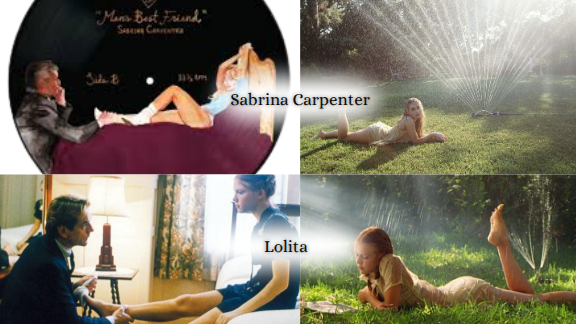Rape is not glamorous.
No one smiles when reading Know My Name by Chanel Miller, or the New York Times stories about young girls who were assaulted in the streets. In fact, we often turn our attention away from rape. It’s considered unkosher to bring up in casual conversation, and you might feel nervous or stammer when you need to say the word. The average reader turns away from such “intense” topics, favoring more digestible genres.
However, one book was so potent, so perfect, that it slipped past our societal defenses. It could be considered one of the most offensive and psychopathic works of the modern era—yet its presence in pop culture is undeniable. The mainstream use of Lolita begs the question: how much freedom is too much freedom in artistic expression?
Lolita
Lolita, by Vladimir Nabokov, is told from the perspective of a French professor, who goes by the pseudonym Humbert Humbert. The young death of Humbert’s first girlfriend causes him to have a sexual obsession with girls ages 12-14 whom he calls “nymphets”.
When Humbert visits a small town in America, he stays as a boarder with a woman named Charlotte. At first Humbert does not want to stay with Charlotte, but when he sees her twelve year old daughter Dolores sunbathing on the lawn, he quickly changes his mind and decides to stay. Charlotte eventually falls in love with Humbert, and realizing the benefits of being Dolores’s step father, he reluctantly marries her. She then discovers Humbert’s feelings for her daughter from his journal, and in a rage storms out of the house, getting hit by a passing car.
Humbert moves Dolores out of town, and continuously rapes and bribes her for sexual favors. He keeps her very tightly controlled and close to him for two years until she eventually runs away at age 14.
The story of Lolita is shocking in and of itself, but the real shock in Lolita is how fearlessly Nabokov writes. The story is told from a perverted, sick perspective, yet uses beautiful language and metaphors throughout the whole book.
Lolita in film
Lolita became popular right after its publication in 1955 (1958 in America), immediately joining the bestseller list and sparking controversy, as people debated whether to censor the book.
In 1962, the film Lolita was re-released. The film coupled the dark, intense theme with beautiful imagery of the American countryside where the story takes place. The main cover is a photo of Dolores herself, wearing heart shaped sunglasses and licking a heart shaped lollipop. The whole scene screams sensuality. This is an interesting choice for the cover of such a seemingly hard and problematic storyline. Yet as you watch the film, you start to realize that Lolita was never intended to be anything short of a delight. The scenic imagery of rolling hills and a beautiful American countryside was not meant to be a part of a cautionary tale. Dolores herself, portrayed by American actress Dominique Swain, is playful, light-hearted, and immediately begins flirting with Humbert. This choice to re-imagine Lolita as an almost double sided, lighthearted romance perfectly captures the essence of modern Lolita.
Lana Del Rey
Lana Del Rey (Elizabeth Woodridge Grant)is a famous singer and songwriter. Lana grew up in NY until she was 14 years old, when she was sent to a Episcopalian boarding school due to her alcohol addiction.
“That’s really why I got sent to boarding school at age 14—to get sober,” she recollects. Years later, while working as a waitress on Long Island, she began writing music and rose to popularity in 2011 with the release of her lead single Video Games. She became known for her achy, melancholic vocals paired with upbeat tracks. Olivia, a student at NYC iSchool, loves Lana’s deep, reflective lyrics and melodies.
“Lana Del Rey uses emotions in her writing and it really makes the listeners feel what she’s trying to say.” She relates.
Lana’s debut album Born to Die includes the songs Lolita, Carmen, Diet Mountain Dew, Off to the Races, and Lucky Ones —all of which reference the novel Lolita by Vladimir Nabokov.
In these songs, she sings from the perspective of Dolores in Lolita. However, none of her lyrics are anything along the lines of, “I was raped repeatedly as a minor by my stepfather who held me hostage for two years.” Instead, her version of Lolita is portrayed as immature, yet submissive and thrilled by love—specifically, the love of someone much older than her.
“My old man is a bad man / but he’s got a soul as sweet as blood-red jam.” In “Off to the Races,” Lana uses direct quotes from Nabokov’s Lolita, but re-contextualizes them through the perspective of Dolores, rather than Humbert. When she sings,
“I’m your little scarlet starlet / singing in the garden / kiss me on my open mouth,” She is directly referring to the line,
“Wanted, wanted: Dolores Haze. Hair: brown. Lips: scarlet. Age: five thousand three hundred days. Profession: none, or ‘starlet.’” Again, in the song Carmen, which is Humbert’s favorite name for Dolores, she sings from the perspective of a hyper-sexualized young girl.
“I’m dyin’, I’m dyin’,” which references the line,
“Dying, dying, Lolita Haze.” These are a very small number of the Lolita references in her songs. In her most recent album, Did You Know That There’s a Tunnel Under Ocean Boulevard, she even refers to herself as “Lanita,” permanently cementing the notion that she sees Lolita as an alter-ego, instead of a discussion topic.

Adrianna Gutierrez, a freshman at NYC iSchool, believes that Lolita should not be used in the music industry like this. She explains, “Knowing the context [of Lolita] I’d be disgusted. I’d probably not want to listen to the artist again because why would you sit there and write that song.”
This view on Lolita in Lana Del Rey’s Lolita songs is not widely shared. Many believe that Lana Del Rey is genuinely expressing her trauma and experiences through her music, and using Lolita helps her do that. However, the way Lana chooses to show Lolita does bring up some issues on sensitivity.
Sabrina Carpenter
Popular singer, songwriter, and actress Sabrina Carpenter rose to fame in 2014 with her Disney channel role as Maya Hart on Girl Meets World. From 2015-2019 she released a few moderately successful albums, but mainly continued to work with Disney as an actress. In 2024, she released the album Short n’ Sweet. The album was a break from her earlier work, and immediately flew up the charts with raunchy and openly sexual hits such as “Bed Chem”
and “Espresso.” This became her signature style, funny and relatable songs dripping with sexual innuendo.
In September 2024, Sabrina Carpenter participated in a photo shoot for W Magazine, which featured her lying on her stomach in a grass lawn, with a sprinkler, in a tan slip dress. The photo is very much like the iconic Lolita scene when Humbert first sees her as he tours Charlotte’s house. Additionally, a limited edition vinyl of her 2025 album “Man’s Best Friend,” shows an illustration of her lying on a bed while a man in a suit with grey hair at the foot of the bed dotes on her and holds her ankle. This parallels an intense scene in Lolita, where Humbert is holding onto Dolores’s ankle as she lays in bed.

Carpenter denies the similarity between her imagery and Lolita, claiming it “was never on her vision board and never would be,” However, critics are saying denying these allegations are pointless, since the images clearly are meant to represent Lolita in some way. Noa Stember, an iSchool student, explains, “I actually think it’s bad that she uses that kind of thing for her young audience.” This is a shared feeling throughout Sabrina’s extensive fan base. The prevailing question seems to be, why does she feel the need to use Lolita to sexual herself, knowing the context?
Is this okay?
Lolita is a story about a pedophile. In essence, Lolita is brutal, cautionary, and blatantly disgusting. Yet it is used by two of the most famous female singers of our generation.
One one hand, Lolita can and has been historically used to glamorize rape and pedophilia. This might make it unethical to use in mainstream art and photography, especially in a possibly sexual context. In contrast to this, Lolita is not biographical. Nabokov wrote Lolita as a fictional work meant to shock and intrigue the masses, but not necessarily spread awareness of pedophilia. The story could be seen as more up for grabs for artistic usage, rather than a sensitive story that should be honored and respected. Lolita is a fictional character, and does not need to always be brought up in a serious manner. Maybe the real issue is not how Lolita is used, but what her use reveals about our culture’s uneasy relationship with real world issues.








